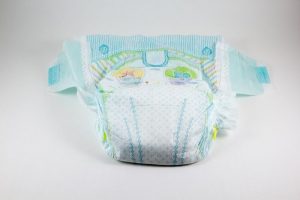This post has been written by Fiona Boorman, Children’s Specialist Nurse.
Product testing regulations in the UK are among the best in the world, so soreness due because of a reaction to something in the nappy itself is unlikely, whether you chose to use disposables or washables.
There are many reasons for children getting nappy rashes from disposable nappies. These include:
- Strong urine (wee), which may irritate the skin. Increasing water and water-based drinks throughout the day, for babies who have weaned, may help make the urine less irritating. Ask your health visitor for advice.
- Both modern cloth and disposable nappes are good at absorbing urine quickly. However, cloth nappies need careful washing and drying to make sure they are properly clean, and disposables need to be changed before they are completely full to ensure that moisture does not remain against the skin.
- Follow the manufacturer’s instructions when washing and drying cloth nappies and consider whether your choice of detergent may be the reason for a skin rash if one develops.
- Children not being changed quickly enough after they poo. It is not always possible to change a child immediately, but wee and poo together can cause nappy rashes.
- Sometimes the child’s diet may increase the likelihood of poo causing skin redness.
- Some children have dry skin, or eczema. They may also get skin infections in their nappy area.
- Some children are sensitive to some wipes. Water and washable wipes may be an alternative.
- If the nappy is too small or fits poorly, it is more likely to cause rubbing and irritate the skin resulting in red areas. Getting the correct size is important. Washable nappies tend to be more adjustable to your child’s changing size as they grow. For disposables you should purchase the correct size – the size usually varies according to your child’s weight.
- If the nappy has leaked or is over filled, the moisture remaining next to your child’s skin and may cause irritation.
- A child who wears a nappy is more prone to have a rash than those wearing cotton pants, as the air is less able to reach the skin. Where possible allow your child some nappy-free time during the day, particularly if skin irritation or nappy rash is a problem.
- Starting to work on the skills for potty/toilet training early is a good way of managing or avoiding nappy rash. Consider sitting your little one on a potty after feeds or drinks, when they learn to sit independently, to see if you can catch a wee or poo. Not only will that reduce the time they have moisture next to their skin, but it may help them develop a skill they need for potty training.
There is more information about potty training on the Bladder & Bowel UK website at: https://www.bbuk.org.uk/toilet-training-resources/.
Signs of poorly fitting nappies

- Red marks on the skin beneath the nappy may be due to rubbing or chafing, often inside the thigh.
- Children may fiddle with their nappy if they are tight or uncomfortable.
- Toddlers may walk awkwardly or even resist having a new nappy put on if they are uncomfortable to wear.
- Disposable nappy tapes may stick to the skin if there is not enough stretch.
- The nappy leaks.
Disposable nappies often fit better if, after taking them from the pack, they are folded in half lengthwise and tugged gently, to help the elasticated cuffs to stand up and act as a more effective leakage barrier. Washable nappies come in a range of sizes, but many will accommodate babies and toddlers across a range of sizes. It is still important to make sure that you use them correctly.
Avoid using talc or barrier creams on your child’s nappy area, as these can block the special one-way pores in the nappy. The pores are designed to let wee through into the nappy quickly and keep it there so your child’s skin stays dry. If your child does need a cream on their nappy area, then use the minimum you can and rub it in well. Do not wipe any excess on the nappy.
Many children with additional needs or disabilities can toilet train at a similar age to their typically developing peers. There is more information on toilet training children with disabilities available on the Bladder & Bowel UK website (www.bbuk.org.uk) at https://www.bbuk.org.uk/children-young-people/children-resources/
If you have any concerns about your child’s skin, nappy rash or other health issue then do consult their health care professional.
Bladder & Bowel UK have a confidential helpline for anyone of any age affected by a bladder and/or bowel condition, including difficulties with potty training. To contact our helpline, complete an online form at: https://www.bbuk.org.uk/helpline-enquiries/



Comments are closed